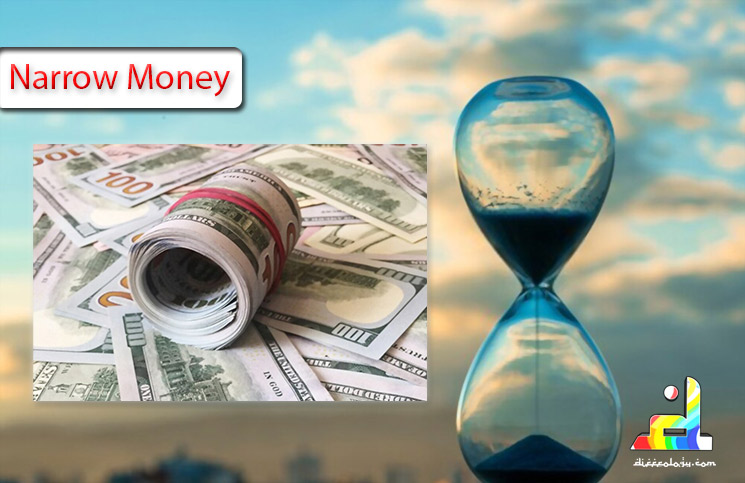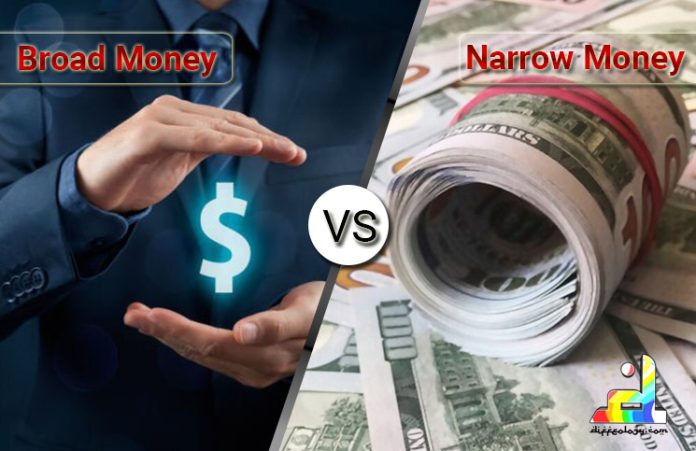Money serves as a means of trade. In the past, products were exchanged through other mediums such as barter, gold, or silver. It is true that some of them continue to be employed in some societies. But money remains the primary means of transaction. For the majority of individuals, money is just that: money. The definition of money, on the other hand, differs by area. Having stated that, each country has its own definition of broad and narrow money. However, what is the Difference Between Broad Money And Narrow Money? Let us investigate.
Main Difference Between Broad Money And Narrow Money
Broad money is defined by the Federal Reserve as M2, which includes not just cash and checking deposits but also short-term money market securities. Narrow money, on the other hand, refers to M1 (cash and checking deposits), or in other words, currency plus checkable savings.
Read Also: Difference Between Overdraft and Loan
How Can You Define Broad Money?

Broad money is a kind of money that encompasses both narrow money and assets that you can quickly convert to cash. In addition, treasury bills, foreign currencies, certificates of deposit, money market accounts, and marketable securities are also available. You may use it to determine the amount of money in circulation, and it is also popular as the most inclusive method of determining a country’s money supply.
Countries use a variety of different techniques to calculate broad money. Consider a few.
- There are many items classified as M0 and M1 that fall under broad money in Canada. This includes foreign currencies, travelers’ checks, time savings deposits, and securities repurchase agreements.
- Money in the United States is classified into two forms: M2 and M1. This includes money market deposits, savings accounts, time deposits, and money market funds.
- In Japan, M3 refers to broad money, which includes all things in M1 and M2, as well as deposits at post offices, banks, and savings institutions.
- M4 and M3H are what people consider broad money in the United Kingdom. As well as M1 and M2 assets, additional assets such as investment certificates, foreign currency deposits, and building society deposits are included.
- In Australia, M3 refers to broad money, which includes all goods in M1 as well as credit unions and building societies affiliated with banks. In Australia, broad money also includes non-bank deposits and currency holdings.
Broad money, on the other hand, is less liquid.
How Can You Define Narrow Money?

This is a categorization of money supply that encompasses all physical money, including currency, central bank-held liquid assets, demand deposits, and coins. The definition of money as used by governments and central banks varies from country to country, as previously mentioned. There is, however, a narrow definition of money in each nation. Narrow money is what you can denote by an M followed by one or more digits or a letter.
Narrow money consists of currency that is in circulation plus checkable deposits. It includes money or demand deposits (checking and other checking deposits) as well as time deposits and balances held by depository institutions at Federal Reserve Banks.
Examples Of Narrow Money
Here are some examples of how various countries refer to narrow money:
You can categorize this money as M0 and M1 in Canada. It comprises circulating banknotes and coins, as well as liquid assets that are easily convertible to cash.
There are two money measures in the United States, M1, and M2, with M1 being the narrowest. U.S. narrow money (M1) contains all cash in circulation, traveler’s checks, demand deposits, and checkable deposits.
M1 is the abbreviation for narrow money in Australia. You can add banknotes, coins, and current bank deposits to it.
M1 is the smallest unit of money in the United Kingdom, consisting of bankers’ deposits and currency in circulation. M2 and M4 are closely related to narrow money.
M1 is the smallest unit of currency in Japan, consisting of deposits, coins, and bills in circulation. M2 follows closely after, including deposits, coins, banknotes in circulation, and certificates of deposit.
Narrow money has a high liquidity level. As a result, it is readily accessible in response to demand.
Parallels Between Broad and Narrow Money
- Both are monetary definitions.
- Both are country-specific.
Difference Between Broad Money And Narrow Money In Detail
Possibly the most important difference between narrow and broad money is that narrow money represents a smaller part of the total money supply. This distinction has been important in the past during times of inflation when the Federal Reserve focused on controlling M1 (narrow) rather than broad. Why is this important? It’s because narrow money tends to be more quickly affected by changes in spending habits than note and coin currency (broad). When people lose confidence in a partic
Possibly the most important difference between narrow and broad money is that narrow money represents a smaller part of the total money supply. This distinction has been important in the past during times of inflation when the Federal Reserve focused on controlling M1 (narrow) rather than broad. Why is this important? It’s because narrow money tends to be more quickly affected by changes in spending habits than note and coin currency (broad). When people lose confidence in a particular currency, they tend to spend it more quickly, thereby making it less available for future spending. When the dollar is loose, it tends to circulate more among the lower-income groups, which can temporarily exacerbate inflation.
Definition
Broad money is a kind of money that encompasses both narrow money and assets that you can convert quickly to cash. Money market accounts, treasury bills, certificates of deposit, and other marketable securities are what you can add to it. As opposed to that, narrow money includes all physical money, such as currency, central bank liquid assets, demand deposits, and coins.
Liquidity
Broad money is less liquid than narrow money.
Indication
M3 or M4 denotes broad money, while M0, M1, or M2 denotes narrow money.ular currency, they tend to spend it more quickly, thereby making it less available for future spending. When the dollar is loose, it tends to circulate more among the lower-income groups, which can temporarily exacerbate inflation.
Read Also: Difference Between Ecommerce And Ebusiness
FAQs: Broad Money vs. Narrow Money
Difference Between Broad Money And Narrow Money Summary
Broad money is a kind of money that encompasses both narrow money and assets. It is easy for you to convert it to cash. You can add foreign currencies, certificates of deposit, money market accounts, treasury bills, and marketable securities to it. Because it is less liquid, it is not readily accessible for expenditure. By contrast, narrow money consists of all physical money. So, you may add currency, central bank liquid assets, demand deposits, and coins to it. It is extremely liquid and readily spendable. So, now you know the Difference Between Broad Money And Narrow Money.
References
- Broad Money: Definition, About Calculation, Example, and Benefits
- Narrow Money Definition vs. Broad Money, Qualifying Accounts




